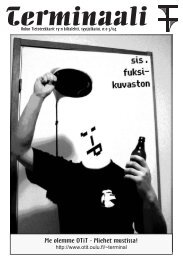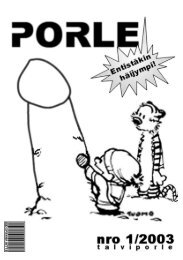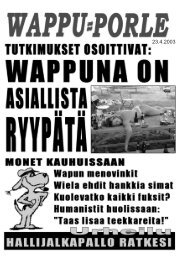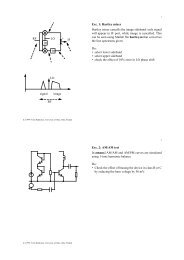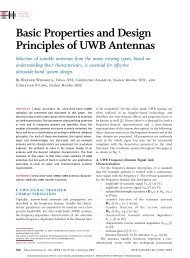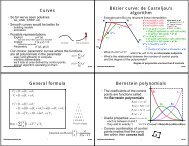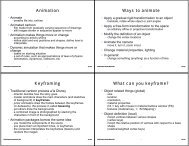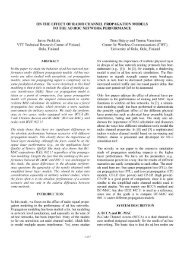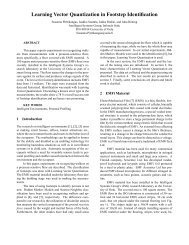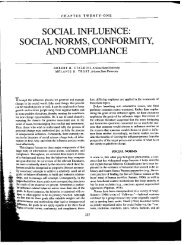Accurate, Dense, and Robust Multiview Stereopsis - Department of ...
Accurate, Dense, and Robust Multiview Stereopsis - Department of ...
Accurate, Dense, and Robust Multiview Stereopsis - Department of ...
You also want an ePaper? Increase the reach of your titles
YUMPU automatically turns print PDFs into web optimized ePapers that Google loves.
FURUKAWA AND PONCE: ACCURATE, DENSE, AND ROBUST MULTIVIEW STEREOPSIS 1365<br />
matching step is to generate a sparse set <strong>of</strong> patches (possibly<br />
containing some false positives). The expansion <strong>and</strong> the<br />
filtering steps are iterated n times (n ¼ 3 in our experiments)<br />
to make patches dense <strong>and</strong> remove erroneous matches. The<br />
three steps are detailed in the following sections.<br />
3.1 Initial Feature Matching<br />
3.1.1 Feature Detection<br />
First, we detect blob <strong>and</strong> corner features in each image using<br />
the Difference-<strong>of</strong>-Gaussian (DoG) <strong>and</strong> Harris operators.<br />
Briefly, let us denote by G a 2D Gaussian with st<strong>and</strong>ard<br />
deviation . The response <strong>of</strong> the DoG filter, at some image<br />
point, is given by D ¼jðG G 0<br />
ffiffi 2<br />
p Þ Ij, where denotes<br />
0<br />
the 2D convolution operator. The response <strong>of</strong> the Harris<br />
filter is, in turn, defined as H ¼ detðMÞ trace2ðMÞ, where<br />
M ¼ G ðrIrI 1<br />
T Þ <strong>and</strong> rI ¼½@I @I<br />
@x @yŠT . rI is computed by<br />
convolving the image I with the partial derivatives <strong>of</strong> the<br />
Gaussian G . Note that ðrIrI 2 T Þ is a 2 2 matrix, <strong>and</strong> G is 1<br />
convolved with each <strong>of</strong> its elements to obtain M. We use<br />
0 ¼ 1 ¼ 2 ¼ 1 pixel <strong>and</strong> ¼ 0:06 in all <strong>of</strong> our experiments.<br />
To ensure uniform coverage, we lay over each image<br />
a coarse regular grid <strong>of</strong> 2 2 pixels blocks <strong>and</strong> return as<br />
features the local maxima with the strongest responses in<br />
each block for each operator (we use<br />
our experiments).<br />
2 ¼ 32 <strong>and</strong> ¼ 4 in all<br />
3.1.2 Feature Matching<br />
Consider an image Ii <strong>and</strong> denote by OðIiÞ the optical center<br />
<strong>of</strong> the corresponding camera. For each feature f detected in<br />
Ii, we collect in the other images the set F <strong>of</strong> features f 0 <strong>of</strong><br />
the same type (Harris or DoG) that lie within two pixels<br />
from the corresponding epipolar lines, <strong>and</strong> triangulate the<br />
3D points associated with the pairs ðf;f 0 Þ. We then consider<br />
these points in order <strong>of</strong> increasing distance from OðIiÞ as<br />
potential patch centers <strong>and</strong> attempt to generate a patch from<br />
the points one by one until we succeed, 4 using the following<br />
procedure: Given a pair <strong>of</strong> features ðf;f 0 Þ, we first construct<br />
a patch c<strong>and</strong>idate p with its center cðpÞ, normal vector nðpÞ,<br />
<strong>and</strong> reference image RðpÞ initialized as<br />
cðpÞ fTriangulation from f <strong>and</strong> f 0 g; ð4Þ<br />
ƒƒƒƒƒƒ! ƒƒƒƒƒƒ!<br />
nðpÞ cðpÞOðIiÞ=jcðpÞOðIiÞj;<br />
ð5Þ<br />
RðpÞ Ii: ð6Þ<br />
Since reconstructed patches are sparse with possibly many<br />
false positives in the initial feature matching step, we<br />
simply assume that the patch is visible in an image Ii when<br />
the angle between the patch normal <strong>and</strong> the direction from<br />
the patch to the optical center OðIiÞ <strong>of</strong> the camera is below a<br />
certain threshold ( ¼ =3 in our experiments) 5 :<br />
n ƒƒƒƒƒ! ƒƒƒƒƒ! o<br />
V ðpÞ IjnðpÞ cðpÞOðIÞ=jcðpÞOðIÞj<br />
> cosð Þ : ð7Þ<br />
4. Empirically, this heuristic has proven to be effective in selecting<br />
mostly correct matches at a modest computational expense.<br />
5. In the next patch expansion step, where patches become dense <strong>and</strong><br />
less erroneous, a simple depth-map test is used for visibility estimation.<br />
Fig. 4. Feature matching algorithm. (a) An example showing the features<br />
f 0 2 F satisfying the epipolar constraint in images I2 <strong>and</strong> I3 as they are<br />
matched to feature f in image I1 (this is an illustration only, not showing<br />
actual detected features). (b) The matching algorithm.<br />
V ðpÞ is also initialized from V ðpÞ by (2). Having initialized<br />
all <strong>of</strong> the parameters for the patch c<strong>and</strong>idate p, we refine<br />
cðpÞ <strong>and</strong> nðpÞ by the patch optimization procedure<br />
described in Section 2.3, then update the visibility information<br />
V ðpÞ <strong>and</strong> V ðpÞ with the refined geometry according to<br />
(7) <strong>and</strong> (2). During the optimization, cðpÞ is constrained to<br />
lie on a ray such that its image projection in RðpÞ does not<br />
change. If jV ðpÞj is at least , that is, if there exist at least<br />
images with low photometric discrepancy, the patch<br />
generation is deemed a success <strong>and</strong> p is stored in the<br />
corresponding cells <strong>of</strong> the visible images (update <strong>of</strong> Qiðx; yÞ<br />
<strong>and</strong> Q i ðx; yÞ). Note that we have used (2) to compute V ðpÞ<br />
before <strong>and</strong> after the optimization, <strong>and</strong> the threshold in (2)<br />
is set to 0.6 <strong>and</strong> 0.3, respectively, because the photometric<br />
discrepancy score <strong>of</strong> a patch may be high before the<br />
optimization with its imprecise geometry. Also note that, in<br />
order to speed up the computation, once a patch has been<br />
reconstructed <strong>and</strong> stored in a cell, all <strong>of</strong> the features in the<br />
cell are removed <strong>and</strong> are not used anymore. The overall<br />
algorithm description for this step is given in Fig. 4. Finally,<br />
let us explain how this matching procedure is able to h<strong>and</strong>le<br />
image artifacts such as specular highlights <strong>and</strong> obstacles<br />
successfully <strong>and</strong> guarantee that reference images do not<br />
contain such artifacts. If the matching procedure starts with<br />
a feature in an image containing artifacts, the image




